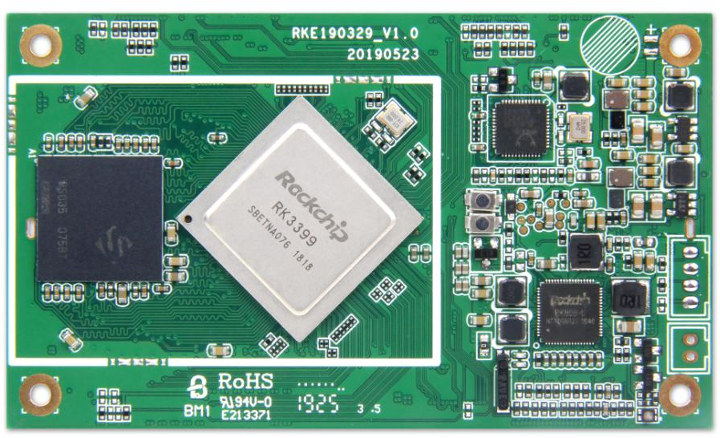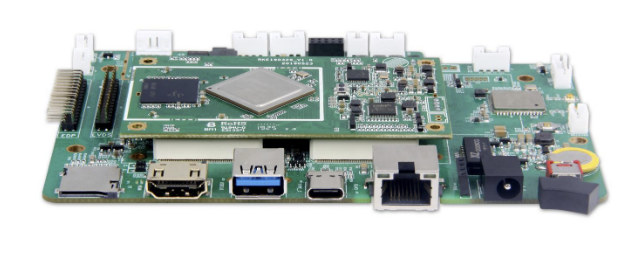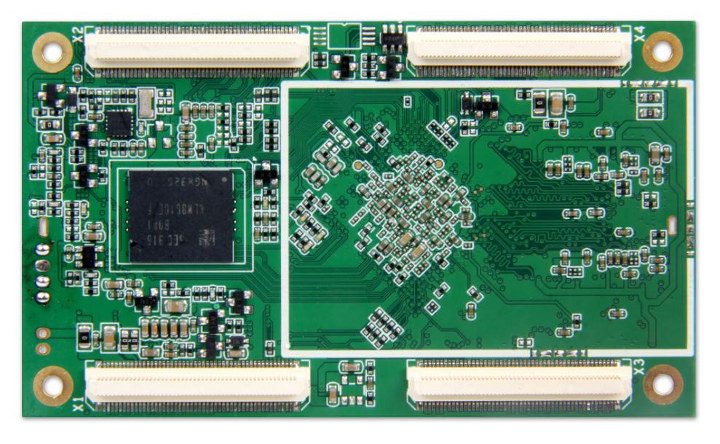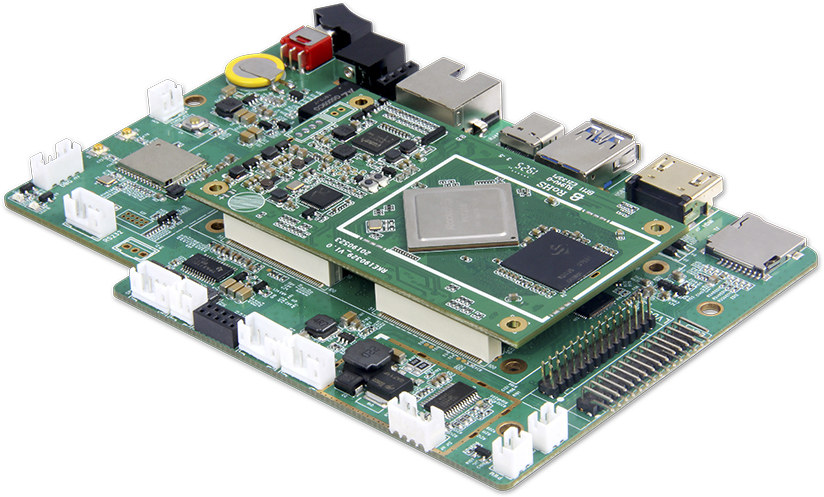96boards System-on-Module specification was introduced last April together with their first SOM-CA (2x board-to-board connectors) and SOM-CB (4x board-to-board connectors), namely TB-96AI & TB-96AIoT modules powered by respectively AI capable Rockchip RK1808 and RK3399Pro processors that would fit into a compatible baseboard.
Those started to ship early this summer, and there’s now a new module that complies with 96Boards SoM specification courtesy of Geniatech SOM3399 powered by a Rockchip RK3399 hexa-core processor without the extra NPU / AI accelerator found in the aforementioned modules.
Geniatech SOM3399

Specifications:
- SoC – Rockchip RK3399 dual-core Cortex-A72 up to 1.8GHz, quad-core Cortex-A53 up to 1.4GHz, Mali-T860 MP4 GPU with support for OpenGL ES1.1/2.0/3.0, OpenCL1.2, DirectX11.1
- System Memory – 2GB LPDDR4 (4GB as option)
- Storage – 8GB eMMC flash (16, 32, and 64GB as option)
- Board-to-board connector – 4x 100-pin high-speed connectors (X1, X2, X3, and X4 as defined by the spec) with USB 3.0, PCIe, Gigabit Ethernet, MIPI DSI/eDP/LVDS, HDMI, MIPI CSI, I2S, I2C, SPI, UART, etc..
- Power – 5V DC supply voltage; Rockchip RK808 PMIC
- Dimensions – 85 x 50 x 6 mm
Android 7.1 & Linux are supported on the software side, but for some reasons, no details were provided in Linaro’s announcement, so maybe software is handled by Geniatech themselves.
96Boards SoM Carrier Board
 While in theory, Geniatech SOM3399 could work with Beiqi’s 96Boards SoM carrier board used by the first 96Boards module, the company decided to make their own simpler carrier board – CBD96-3399 – with the following (preliminary) specifications:
While in theory, Geniatech SOM3399 could work with Beiqi’s 96Boards SoM carrier board used by the first 96Boards module, the company decided to make their own simpler carrier board – CBD96-3399 – with the following (preliminary) specifications:
- SoM support – Geniatech SOM3399 or other 96Boards SoM compliant modules
- Storage – MicroSD card slot
- Video Output – HDMI 2.0 port, LCD display via high-speed connector
- Camera – Support for up to 2x 13MP camera via high-speed connector
- Connectivity – Gigabit Ethernet, dual-band 802.11ac WiFi 5, Bluetooth 4.2, GPS
- USB – 1x USB 3.0 port, 1x USB Type-C port
- Expansion Headers
- 96boards 40-pin Low-Speed connector with 2x UART, SPI, I2S, 2x I2C, 12x GPIO, DC power
- 96boards 60-pin High-Speed connector with 4L-MIPI DSI, LVDS, USB, 2x I2C, 2L+4L-MIPI CSI
- 60-pin High-Speed connector with secondary 4L-MIPI DSI, SSC serial
busses, TS I/F - 2x Analog expansion connector for headset, speaker via sound-wire
interface, microphones, line-outs
- Misc – Power switch, RTC battery
- Power Supply – 12V via power barrel jack
- Dimensions – 126 x 124mm
I can’t see any 96Boards low-speed nor high-speed connectors on the photos above, so those connectors are just placed under the board.
Pricing for SOM3399 module and CBD96-3399 carrier board is not available, and instead, you’d need to click on “Buy Quantity” to request the price on the respective product pages here and there.

Jean-Luc started CNX Software in 2010 as a part-time endeavor, before quitting his job as a software engineering manager, and starting to write daily news, and reviews full time later in 2011.
Support CNX Software! Donate via cryptocurrencies, become a Patron on Patreon, or purchase goods on Amazon or Aliexpress







When you say “I can’t see any 96Boards low-speed nor high-speed connectors on the photos above, so those connectors are just placed under the board.”… Are you referring to the Consumer Edition 40 and 60 pin low and high speed interfaces? If so, from where are you getting the information that these interfaces are actually present on this board? Neither the Linaro announcement, nor the manufacturer’s website hint at these interfaces being present, and in fact, they are ONLY mandatory on the Consumer Edition boards.
I believe that may have mistakenly assumed these interfaces were part of the SoM spec just because they happen to be present on the first carrier board.
Edit: nevermind, I see where you saw it. But I still wouldn’t count on it since it could be copy/paste error.